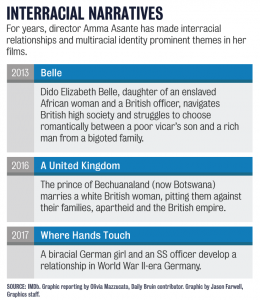Diversity in film and television came into the spotlight in 2016 with #OscarsSoWhite. A USC study in 2016 found only about a quarter of speaking characters belonged to non-white racial/ethnic groups. In “Reel Representation,” columnist Olivia Mazzucato discusses different issues of race and representation in media as they relate to new movies and TV shows.
The closest I’ve ever felt to seeing myself on screen is when I watched the film “Belle.”
“Belle” tells the story of Dido Elizabeth Belle, the daughter of an enslaved African woman and a white British officer. She’s brought to England and raised by her uncle, an earl and the Lord Chief Justice, and finds herself facing a choice between two men – a poor vicar’s son, whom she loves, and a naive aristocrat with a bigoted family. Throughout the film, she tries to reconcile her identities, both as an heiress in the British upper class and as a black woman struggling to find her place in a shifting society.
I may not be able to relate directly to Dido’s life, but her struggles with identity are all too familiar to me.
As someone who is biracial – half Italian-American and half Japanese-American – it’s difficult to process my identity, particularly when it comes to seeing myself represented in media. I don’t look like the white female characters I see, nor the few Asian characters that occasionally grace the screen. On some level, I feel like I’ll never truly be represented because my identity is so specific.
[Last Week: Asian-Americans gravely underrepresented in mainstream cinema]
Films that tackle the idea of multiracial identity, like “Belle,” are rare, but tell important stories that reflect the shifting nature of race and culture. The easiest way to ensure that diverse narratives are told is by supporting filmmakers who come from varied backgrounds, allowing them to share stories that draw from their personal experiences.
Racial identity in our world today is constantly evolving. The multiracial population in the United States is increasing, as is the rate of interracial marriage, according to the Pew Research Center. More people are starting to come from complex backgrounds, but it’s not a topic that’s always well reflected in films and television shows.
Racial identity is hard enough to portray, and multiracial identity is only more elusive. Multiracialism is not the lack of acceptance so much as a lack of clear identity. For me, the struggle with my identity stems not as much from others’ disapproval but my search for a sense of belonging.
“Belle” captures the difficulty of having a multiracial ethnicity. In one scene, Dido has to dine separately from her adoptive family in the presence of other white house guests. Simultaneously, she is unable to dine with the servants because of her elevated social rank. Her two identities directly oppose each other and prevent her from finding her place.
I know the feeling all too well. I was part of an agency that cast extras for films when I was younger, and my race was listed as white and Asian. However, I rarely got called to fill white roles and when I was called for Asian roles, I was told I didn’t look Asian enough. I was undeniably white and Asian, but not enough to qualify me as a member of either category.
The feeling of an absence of identity is just one reason that multiracial identity makes for difficult subject matter. “Belle” is able to tackle such issues due to the skill of the film’s director, Amma Asante.
“Belle” is Asante’s second film. Although she hasn’t made many films, in all of her projects, past and present, she chooses to tell stories about complex racial identity with comprehensive nuance.
[Read more: Shonda Rhimes normalizes diversity in TGIT lineup]
Her 2016 film, “A United Kingdom,” tells the story of the interracial marriage between an African prince and a white British woman. In her upcoming film, “Where Hands Touch,” she tackles the story of a relationship between a mixed-race German girl and an SS officer during World War II.
In the hands of any other director, I might feel nervous about the execution of such difficult stories. But I feel confident in Asante’s ability, both as a director and as someone who understands the intricacies of race.
Asante’s storylines succeed because they acknowledge the complexity of race and its intersection with other identities. Dido’s identity is fraught because she is both biracial and an upper-class woman. Her relationships with her suitors are impacted by her race, but also by her economic standing and theirs. Storylines about multiracial identity succeed not because of their singular focus on race, but because they acknowledge that race is just one factor that acts upon these characters’ existences.
Asante is also a clear example of the effect of diversity in Hollywood behind the camera, rather than simply in front of it. Asante comes from a bicultural background, growing up in England as the child of Ghanaian immigrants. She is married to a Danish man, which seems to lend a dimension of insight to her portrayals of interracial marriage. She describes her existence as being an “unfamiliar and familiar character in the world,” an intangible concept she captures in characters like Dido.
[Read more: ‘Hidden Fences’ gaffe depicts worrying outlook on representation]
Asante brings aspects of her own life and experience to the screen, telling stories with complexity and compassion. It’s important that studios recognize the perspectives that filmmakers of color bring to their work and support filmmakers from different racial backgrounds in order to diversify the stories that are told in films and television shows.
“A United Kingdom” comes out Friday in the US and “Where Hands Touch” is slated to come out this year. Although Asante has not announced her next project, I am confident her work will continue to shape the conversation on the intersection of racial identity and film.

